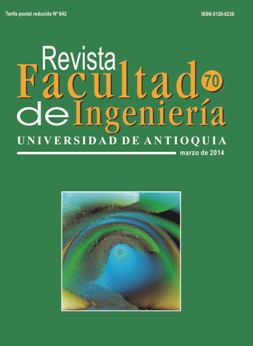Design, construction and tests of an automatic prototype for composting
DOI:
https://doi.org/10.17533/udea.redin.18662Keywords:
compost, automatic prototype, solid organic residuesAbstract
In this work the design, prototype construction and experimental validation of a composter is presented. The prototype performs the composting process of organic solid residues in an automatic form and the design is based on the treatment residues generated at home and on the composting proper process requirements to be carried out in a suitable way. This device has the property of processing, in a continuous way, 3 kg of solid organic residues per day. The residues introduced in the prototype remain inside for a 30-day period, time in which they are transformed into compost. The control of the prototype is achieved by a microcontroller, having the following functions; temperature control, air flow provision(aerobic decomposition), material stirringfor a uniform decomposition and material movement over the band (from the entrance up to the exit of the device) to achieve a continuous processing of the residues. The resulting tests provided a compost with a dun obscure color, without smells, and at room temperature. All of these conditions were indicators of a stable compost.
Downloads
References
Secretaría del Medio Ambiente y Recursos Naturales. Guía para la gestión integral de los residuos sólidos municipales. Subsecretaría de Gestión para la Protección Ambiental-SEMARNAT. México DF., México. 2001. pp. 7-13.
Instituto Nacional de Estadística, Geografía e Informática (INEGI) 2002. Estadísticas a propósito del día mundial del medio ambiente, bases conceptuales y procedimientos. Organización Panamericana de la Salud. Disponible en: http://www.inegi.gob.mx; http://www.consumosustentable.org/4_5.htm. Consultado: Diciembre 2009.
R. Avendaño, A. Daniella, C. Bonomelli. El proceso de compostaje. Facultad de Agronomía e Ingeniería Forestal, Pontificia Universidad Católica de Chile. Santiago de Chile, Chile. 2003. pp 1-7.
M. Sauri, R. María, B. Castillo. “Utilización de la composta en procesos para la remoción de contaminantes”. Ingeniería Revista académica. Vol. 006. 2002. pp. 55-60.
N. Trautmann, M. Krasny. Composting in The Classroom. Ed. National Science Foundation. Cornell Waste Management Institute and Cornell Center for the Environment. New York, USA. 1997. pp. 41-50.
Cornell composting. The Science and Engineering of Composting. Avaliable on: http://www.css.cornell.edu/compost/science.html. Accessed: December 2009.
K. Nakasaki, M. Shoda, H. Kubota. “Effect of Temperature on Composting of Sewage Sludge”. Research Laboratory of Resources Utilization, Applied and Environmental Microbiology 50. 6th ed. Ed.Tokyo Institute of Technology. Yokohama, Japan. 1995. pp. 1526-1530. DOI: https://doi.org/10.1128/aem.50.6.1526-1530.1985
J. Torres Sandoval. Diseño y construcción de un prototipo automático para preparar composta. Tesis de Maestría en Ciencias. Departamento de Ingeniería Mecatrónica, Centro Nacional de Investigación y Desarrollo Tecnológico. Cuernavaca, México. 2010. pp. 11-27.
R. Navarro. Manual para hacer composta aerobica. Ed. CESTA. Amigos de la Tierra. San Salvador, El Salvador. 1999. pp. 1-21.
Organización Panamericana para la Salud. Organización Mundial de la Salud. Manual para la elaboración de compost bases conceptuales y procedimientos. Ed. Pro Salute Novi Mundi. Montevideo, Uruguay. 1999. pp. 17-30.
F. Brinton. Compost quality standards & guidelines. Project Manager Final Report. New York State Association of Recyclers. Woods End Research Laboratory. Mount Vernon, USA. 2000. pp. 13-18.
I. Martínez, P. Villezca. “La alimentación en México: un estudio a partir de la Encuesta Nacional de Ingresos y Gastos de los Hogares”. Revistas de información y análisis. No. 21. 2003. pp. 26-37.
C. Ponce, G. Mascareñas. Tutorial Canasta Básica: “¿De Cuanto es su Tasa Real Personal de Interés?”. Fuente PROFECO. 2005. pp. 1-4.
I. López, G. Rodríguez. Los recursos fitogenéticos de México. Informe Nacional Sobre el Estado de los Recursos Fitogénicos para la Agricultura y la Alimentación. Instituto de Manejo y Aprovechamiento de Recursos Fitogenéticos (IMAREFI). Departamento de Producción Agrícola, Universidad de Guadalajara. SAGARPA. Guadalajara, México. 2004. pp. 13-29.
J. Silveira. Teoría y cálculo de máquinas agrícolas. 1st ed. Ed. Pueblo y educación. La Habana, Cuba. 1999. pp. 20-49.
C. Villaseñor. Máquinas de transporte y elevación en procesos agroindustriales. Tesis en Ingeniería Agrícola. Depto. de Ingeniería Mecánica Agrícola, Universidad Autónoma Chapingo. Chapingo, México. 1994. pp. 35-48.
R. Bundynas, J. Keith Nisbett. Diseño en ingeniería mecánica de Shigley. 8th. ed. Ed. McGrawHill/ Interamenricana S.A. México DF., México. 2008. pp. 146-170.
Instituto Nacional de Normalización. Compost, clasificación y requisitos. Norma Chilena Oficial NCh 2880. Santiago de Chile, Chile. 2004. pp. 1-10.
Downloads
Published
How to Cite
Issue
Section
License
Copyright (c) 2018 Revista Facultad de Ingeniería

This work is licensed under a Creative Commons Attribution-NonCommercial-ShareAlike 4.0 International License.
Revista Facultad de Ingeniería, Universidad de Antioquia is licensed under the Creative Commons Attribution BY-NC-SA 4.0 license. https://creativecommons.org/licenses/by-nc-sa/4.0/deed.en
You are free to:
Share — copy and redistribute the material in any medium or format
Adapt — remix, transform, and build upon the material
Under the following terms:
Attribution — You must give appropriate credit, provide a link to the license, and indicate if changes were made. You may do so in any reasonable manner, but not in any way that suggests the licensor endorses you or your use.
NonCommercial — You may not use the material for commercial purposes.
ShareAlike — If you remix, transform, or build upon the material, you must distribute your contributions under the same license as the original.
The material published in the journal can be distributed, copied and exhibited by third parties if the respective credits are given to the journal. No commercial benefit can be obtained and derivative works must be under the same license terms as the original work.










 Twitter
Twitter